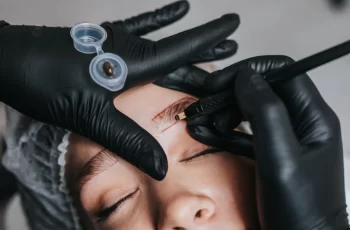
Can I use azelaic acid in the morning?
When we think of skincare ingredients that can exfoliate, a few popular acids come to mind. Glycolic, lactic, and salicylic acids are the clear leaders, but there’s one underdog: azelaic acid.
Although azelaic acid can work in a similar way, it shouldn’t be confused with other AHAs or BHAs because this acid is actually a dicarboxylic acid. This acid peel removes dead skin cells that build up on the surface of the skin and unclogs pores. Plus, it’s rich in antioxidants. This allows azelaic acid to help protect the skin’s lipid barrier, keeping it strong and functional.
All of this sounds impressive, right? The final benefit of azelaic acid is that it’s one of the gentlest acids, helping to rejuvenate the complexion and is suitable for all skin types, even sensitive skin. However, I still recommend consulting a doctor or dermatologist before incorporating them into your daily skin care routine. It goes without saying that the percentages used in formulas with or without azelaic acid vary, from high concentrations of 20% in prescription formulas to lower percentages in over-the-counter formulas. There’s no denying that your skin will love the benefits of this acid, and you’ll soon be blown away by its effects. If you want to know more about azelaic acid and its benefits, read our dedicated blog post.
Now that we’ve briefly reviewed what the acid does to your skin, let’s move on to answering some of the questions we’ve received about this ingenious ingredient. So, let’s get started with whether or not you can use azelaic acid in the morning.
Should I use azelaic acid in the morning or at night?
That depends on the opinion of the dermatologist you speak to. Some prefer to use it in the morning, while others recommend using it only at night. When incorporating azelaic acid into your routine, consider your skin type and the other active ingredients you regularly use. Because to reap the benefits of azelaic acid, you may need to make some changes to your routine. For example, if you already use a salicylic acid serum at night, you can replace it with azelaic acid. This way, your skin will benefit from both ingredients and avoid unnecessary irritation and breakouts.
If you want my advice, I recommend using azelaic acid at night, especially if you use prescription products. This acid exfoliates the skin and repairs any damage caused by its antioxidant properties. Without the effects of free radicals such as UV rays and pollution, the active ingredients work while you sleep, leaving you with a refreshed, healthy complexion in the morning.
Can I use azelaic acid during the day?
Yes, you can use azelaic acid during the day. In fact, you can apply azelaic acid twice a day. However, this is only possible once your skin has become accustomed to the powerful power. You can achieve this by initially applying azelaic acid once a day on your face. The easiest way to see how your skin reacts to azelaic acid is to do a 24-hour patch test. Simply apply 10p of the product to the inside of your forearm and leave it on for 24 hours. Once this time has passed and you have not noticed any signs of irritation, dryness or reaction, you can try the product on your face.
Another important step you must always follow in order to protect your skin and allow the acid to work is to apply SPF 50 every day, even on cloudy and overcast days, as UVA is constantly present and can penetrate clouds, water and glass.
Can I use azelaic acid in the morning and retinol in the evening?
Of course, as I mentioned, you can use azelaic acid twice a day, but you should avoid this when using retinol. Stacking these active ingredients together can cause excessive exfoliation, which can lead to redness, itching, flaking skin, irritation, and general discomfort. This doesn’t mean you have to miss out on the benefits of both ingredients. If you use azelaic acid in the morning and then retinol in the evening, there will be enough time between applications to avoid unwanted side effects.
Can you use a moisturizer after using azelaic acid?
You actually can. I recommend choosing a moisturizer that has a good hydrating effect with nourishing ingredients like hyaluronic acid, niacinamide, or vitamin E. The benefit of applying a moisturizer after using azelaic acid is that not only does it allow the active ingredients to fully penetrate the skin, but the moisturizer formula itself forms a physical barrier on the surface of the skin. This barrier prevents free radicals, environmental impacts, and other harmful agents from penetrating the surface of the skin and damaging the epidermis.
Can azelaic acid reduce acne scars?
Yes, azelaic acid can help reduce the appearance of acne scars. If you don’t know what acne scars are, they usually form on the skin after a dark spot outbreak. If left untreated, they can become more pigmented when exposed to the sun, leading to an uneven skin tone. Azelaic acid can fight these acne scars by gently removing the layer of dead skin cells on the surface of the skin. By clearing these deposits from the skin, it can help to brighten the skin and make the pigmentation of acne scars less noticeable.
I hope this answers your questions about using azelaic acid in the morning. If you have any further questions, don’t forget to reach out to our skincare experts on Instagram.


